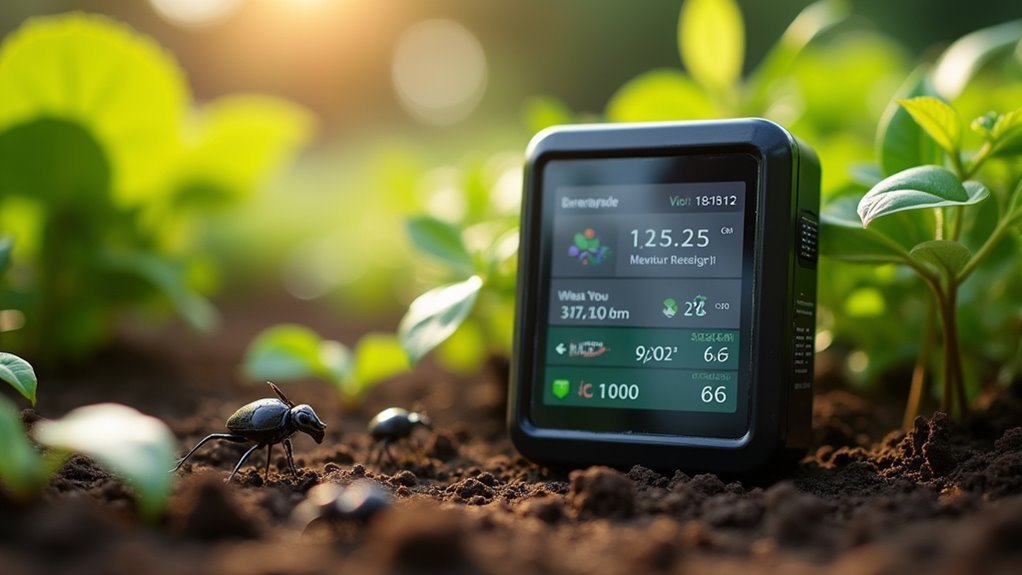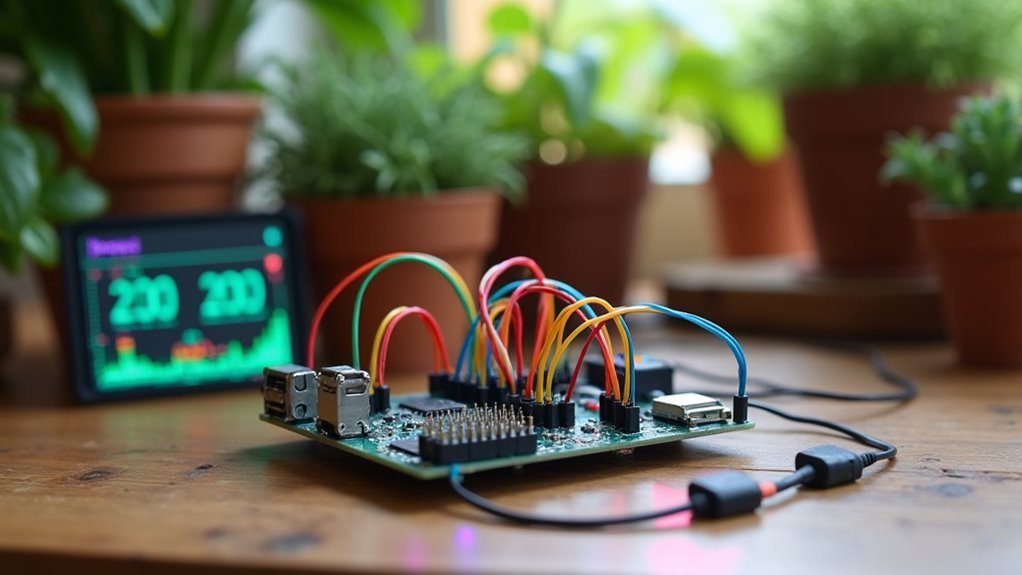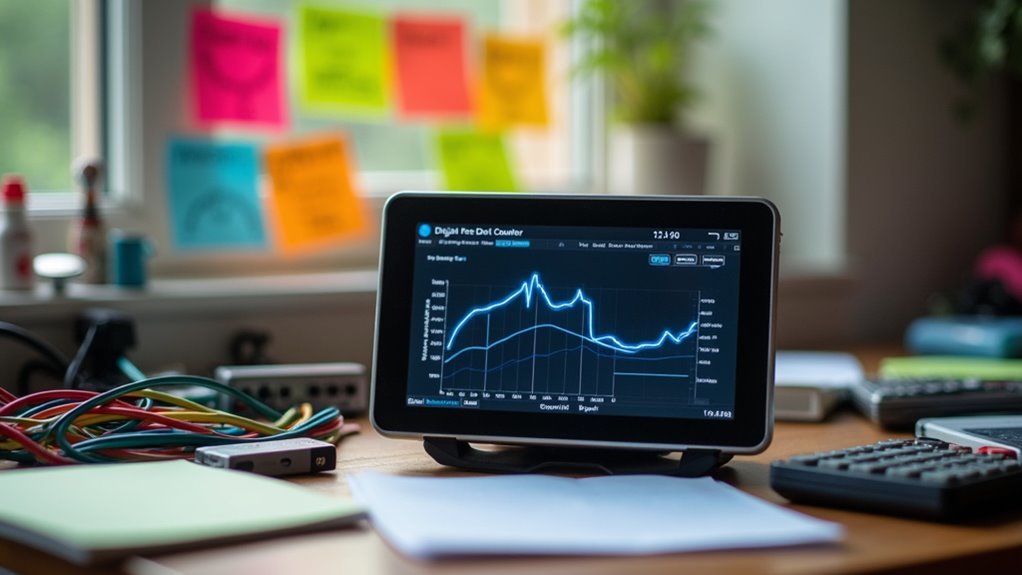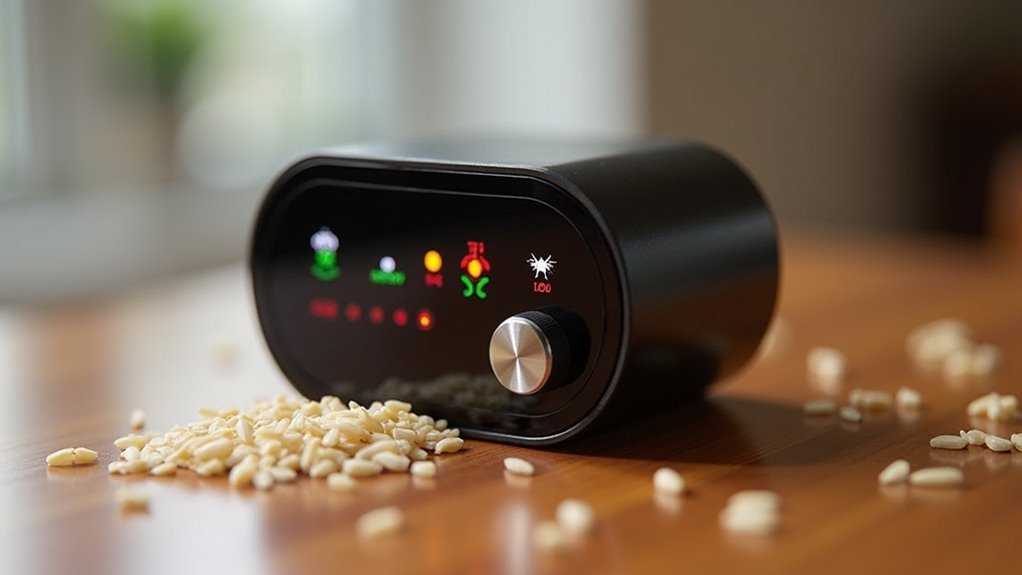You can build a budget digital pest counter using affordable microcontrollers like Arduino Uno ($2-5) or ESP32, basic sensors for detection, and open-source software for data analysis. These DIY systems utilize cost-effective components such as smart traps ($50-$150), enhanced pheromone traps (under $75), and cloud-based storage platforms. While they may lack the durability of commercial systems, budget counters offer essential monitoring capabilities with real-time alerts through smartphone apps, making professional-grade pest detection accessible for under $100 total investment.
Essential Components for Low-Cost Digital Pest Monitoring

When building a budget-friendly digital pest monitoring system, you’ll need several key components that deliver effective results without breaking the bank.
Automated monitoring systems form the foundation, using affordable sensors to detect pest presence without expensive manual inspections.
Affordable sensors eliminate costly manual inspections while providing reliable automated detection of pest activity throughout your property.
You’ll want cost-effective software solutions that analyze data and provide real-time alerts for timely interventions.
Smartphone apps streamline the process by letting you track pest sightings and communicate efficiently with professionals.
Smart traps equipped with basic connectivity options offer ongoing monitoring without costly equipment investments.
Cloud-based platforms serve as budget-friendly options for data storage and analysis, maintaining detailed records of pest activity and treatment effectiveness.
These components work together to create an efficient, affordable digital pest management solution.
Sensor Technology Options That Won’t Break the Bank
Smart sensor technology forms the backbone of any effective digital pest monitoring system, and you don’t need to spend a fortune to get reliable detection capabilities.
Budget-friendly options make pest control accessible without compromising effectiveness.
Here are three cost-effective sensor technology approaches:
- Ultrasonic repellers – These devices emit high-frequency sounds that deter rodents and insects for just $20-$50 per unit, providing continuous protection without ongoing costs.
- Smart traps with connectivity – Brands like Victor and Rat Zapper offer real-time alerts and data collection for $50-$150, eliminating guesswork from your pest management strategy.
- DIY sensor solutions – Using Raspberry Pi or Arduino, you’ll create custom detection systems under $100 that combine motion sensors and cameras for thorough monitoring.
Enhanced pheromone traps and integrated pest management systems with moisture sensors provide additional affordable detection layers for under $75.
Microcontroller Selection for DIY Pest Detection Systems

Three primary microcontroller platforms dominate the DIY pest detection landscape, each offering distinct advantages for your monitoring system.
Arduino Uno provides excellent community support and costs just $2-5, making it ideal for budget-friendly options.
Arduino Uno’s affordability at $2-5 combined with robust community resources makes it the top choice for cost-conscious pest detection projects.
The ESP32 delivers superior processing power while maintaining low-power consumption for battery-operated setups.
Raspberry Pi offers advanced data processing capabilities for complex detection algorithms.
When making your microcontroller selection for DIY pest detection systems, prioritize multiple sensor interfaces to accommodate ultrasonic, infrared, and motion sensors.
The ESP8266 excels in remote applications due to its Wi-Fi connectivity and energy efficiency.
Arduino’s extensive library ecosystem simplifies sensor integration, while low-power microcontrollers like ESP32 extend operational life considerably.
Consider your project’s complexity, power requirements, and budget constraints.
Power Management Solutions for Extended Battery Life
Battery optimization becomes your next priority after selecting the right microcontroller for your pest detection system.
Power management solutions can extend battery life by 50% through strategic component choices and intelligent operation modes.
You’ll maximize efficiency by implementing these key strategies:
- Energy-efficient sensors and low-power microcontrollers – These components dramatically reduce baseline power consumption during active monitoring.
- Sleep modes with adaptive power management – Your device conserves energy during inactive periods while maintaining monitoring capabilities.
- Solar charging capabilities – Harness ambient light for continuous outdoor operation without battery replacement concerns.
Smart algorithms that analyze usage patterns help optimize power consumption based on your specific monitoring needs.
Data Storage and Transmission Methods on a Tight Budget

You’ll need efficient data storage and transmission methods that won’t break your budget when building a digital pest counter.
Cloud storage solutions offer scalable, pay-as-you-use options that eliminate expensive hardware investments while providing reliable access to your pest monitoring data.
Wireless data transfer capabilities and cost-effective memory options can further streamline your system without compromising functionality or security.
Cloud Storage Solutions
When you’re operating a digital pest counter system on a limited budget, cloud storage emerges as one of the most practical solutions for managing your data without breaking the bank.
Cloud storage solutions like Google Drive, Dropbox, and Microsoft OneDrive provide cost-effective data storage with free tiers and affordable subscription plans that’ll help you reduce costs considerably.
Here’s why cloud storage benefits your budget pest control operation:
- Enhanced Collaboration – Your team can access and share data instantly, ensuring everyone stays updated without physical storage limitations.
- Robust Security Measures – Built-in encryption and multi-factor authentication protect sensitive information, maintaining customer trust.
- Reliable Backups – Automatic backups and version control safeguard against data loss, ensuring continuity of operations.
You’ll eliminate expensive hardware investments while gaining professional-grade data management capabilities.
Wireless Data Transfer
Wireless connectivity revolutionizes how you’ll transmit data from your pest counters without the hefty price tag of traditional wired infrastructure.
Wi-Fi and Bluetooth enable cost-effective communication between devices, making them perfect for budget-sensitive applications. You’ll find low-power wide-area networks like LoRaWAN and Sigfox particularly valuable, delivering widespread connectivity with minimal energy consumption and financial investment.
When working with low-bandwidth networks, protocols such as MQTT and CoAP optimize your data transmission efficiently.
You can implement data compression techniques to reduce packet sizes, resulting in faster speeds and lower transfer costs. Combined with cloud storage solutions, you’ll achieve scalable access to data while eliminating expensive physical storage requirements, creating an affordable yet robust pest monitoring system.
Cost-Effective Memory Options
Beyond wireless transmission capabilities, your pest counter needs affordable storage solutions that won’t drain your budget. Cost-effective data management doesn’t require expensive hardware investments when you choose the right approach.
Here are three budget-friendly storage strategies:
- Cloud-based solutions – Reduce upfront hardware costs while gaining scalable storage that grows with your needs.
- Local data storage using SD cards or USB drives – Implement low-cost, high-capacity storage for quick access to critical information.
- Open-source software platforms – Eliminate licensing fees for data management and analytics tools.
You can also leverage existing smartphone technology for data collection, eliminating additional hardware purchases.
These cost-effective options guarantee your digital pest counter operates efficiently without breaking your budget, providing reliable storage solutions that support your pest control operations.
Housing and Weatherproofing Materials for Outdoor Use
Although your digital pest counter’s internal components function flawlessly indoors, you’ll need robust housing and weatherproofing materials to protect the device when deployed outdoors. High-density polyethylene and treated wood offer superior moisture resistance and durability against UV rays and temperature fluctuations. These weatherproofing materials prevent environmental damage while maintaining structural integrity.
| Material Type | Key Benefits |
|---|---|
| High-Density Polyethylene | UV resistance, lightweight |
| Fiberglass | Temperature stability, strength |
| Treated Wood | Natural appearance, rot resistance |
| Silicone Sealants | Flexible, waterproof barrier |
| Polyurethane Caulks | Gap filling, pest exclusion |
You’ll want quality sealants and caulks to eliminate gaps that allow pest entry. Proper weatherproofing reduces energy costs by improving insulation efficiency. Regular maintenance guarantees continued protection against infiltration vulnerabilities.
Software Development Tools for Custom Pest Counter Applications
While hardware protection keeps your pest counter running outdoors, the software that powers your device determines its intelligence and functionality.
Software development tools enable you to create custom pest counter applications that transform basic sensors into intelligent monitoring systems.
Essential Development Components:
- Programming Languages & Frameworks – Python, Java, and JavaScript provide robust libraries for pest identification and data analysis, while React Native and Flutter enable cross-platform mobile app development for iOS and Android devices.
- Data Storage Solutions – MySQL and MongoDB databases efficiently store pest population data and treatment histories, ensuring reliable information retrieval over time.
- Advanced Intelligence Features – Machine learning algorithms analyze historical patterns to improve pest identification accuracy and predict infestations, while APIs from pest control providers offer real-time treatment updates.
Integration With Smartphone Apps and Cloud Platforms
Once you’ve built your custom pest counter application, connecting it to smartphone apps and cloud platforms transforms your device from a standalone monitor into part of a thorough pest management ecosystem.
Integration with smartphone apps provides real-time monitoring and alerts directly to your phone, while user-friendly interfaces let you log sightings and schedule treatments effortlessly.
Cloud platforms store your pest control data, enabling pest management professionals to analyze trends and develop targeted strategies.
IoT technology compatibility allows remote access from anywhere, making pest prevention more responsive. You’ll receive educational resources through your app, and cloud-based systems enable seamless communication between homeowners and pest control companies regarding service schedules and treatment effectiveness updates.
Calibration and Accuracy Considerations for Homemade Devices
You’ll need to establish reliable DIY calibration methods to guarantee your homemade pest counter delivers accurate results in real-world conditions.
Testing your device’s accuracy against known standards or commercial counters helps you identify measurement discrepancies and fine-tune performance.
Implementing systematic accuracy testing protocols with standardized counting intervals will validate your device’s effectiveness and maintain consistent data quality over time.
DIY Calibration Methods
Since homemade digital pest counters lack factory calibration, you’ll need to establish your own accuracy benchmarks using readily available reference materials.
DIY calibration methods guarantee your device accurately detects pests by testing against controlled traps or known specimen weights.
Environmental factors like temperature and humidity affect sensor performance, requiring adjustments to maintain precision.
Here’s your calibration approach:
- Test sensitivity settings for each pest species, as different insects produce varying detection signals.
- Conduct regular monitoring sessions comparing your device readings against established counting methods.
- Utilize software tools and mobile apps for data analytics to track pest populations over time.
Recalibrate after environmental changes or device repairs.
These methods help maintain consistent accuracy without expensive professional calibration services.
Accuracy Testing Protocols
After establishing basic calibration procedures, implementing systematic accuracy testing protocols becomes your next priority for maintaining reliable pest detection.
You’ll need to establish standardized reference points and conduct periodic checks against known quantities to verify consistent readings over time. Control environmental factors like temperature and humidity during testing, as these greatly impact your device’s performance tracking capabilities.
Use statistical methods to assess precision by calculating mean and standard deviation of repeated measurements. This approach helps identify variations in your counter’s output and determines reliability thresholds.
Schedule regular maintenance and recalibration sessions, especially after heavy usage or environmental exposure. Document all testing results to track performance trends and identify when calibration adjustments become necessary for maintaining ideal accuracy standards.
Cost-Effective Manufacturing and Assembly Techniques
Three key strategies can greatly reduce your manufacturing costs when producing budget digital pest counters. Cost-effective manufacturing relies heavily on smart design choices and streamlined processes that maintain quality while cutting expenses.
- Implement modular designs with lightweight materials – You’ll save considerably by using ABS plastic or aluminum components that snap together easily, reducing both material and labor costs while enabling quick repairs.
- Deploy automated assembly lines – You can eliminate human error and boost efficiency by automating repetitive tasks, resulting in faster production times and lower overall production costs.
- Apply lean manufacturing principles – You’ll optimize resource use and minimize waste, potentially achieving 30% cost savings while integrating IoT sensors to enhance product functionality without significantly increasing expenses.
Maintenance Requirements and Troubleshooting Common Issues
You’ll need to establish consistent calibration routines to keep your budget digital pest counter delivering accurate readings throughout its service life.
When device malfunctions occur, you can resolve most issues by following systematic troubleshooting steps that address common hardware and software problems.
Regular maintenance and quick problem-solving skills will maximize your investment’s reliability and extend the counter’s operational lifespan.
Regular Calibration Procedures
While accurate measurements depend on consistent device performance, maintaining your budget digital pest counter requires establishing a regular calibration schedule every six months or whenever you notice environmental changes in your monitoring area.
Following proper maintenance procedures guarantees your device delivers reliable results throughout its lifespan.
Your regular calibration routine should include these essential steps:
- Clean all sensors and calibration surfaces to remove debris that could interfere with readings
- Perform the calibration sequence according to your manufacturer’s guidelines for your specific model
- Complete a test run after calibration to verify accuracy before resuming normal operations
When troubleshooting issues like inconsistent readings, reset your device or update the software.
Always consult your manufacturer’s guidelines to identify model-specific requirements and recommended calibration intervals for best performance.
Device Malfunction Solutions
Even with proper calibration, your budget digital pest counter may experience malfunctions that require immediate attention to restore accurate monitoring capabilities.
When your device stops recording data correctly, first verify proper installation and check for physical obstructions blocking sensors. Connectivity problems represent the most common malfunction; troubleshooting steps include confirming network range and performing device resets when necessary.
Most budget digital pest counters include built-in diagnostic tools that help identify specific errors quickly. You’ll want to familiarize yourself with these features for faster problem resolution.
Additionally, schedule regular firmware updates through the manufacturer’s app or website to fix bugs and enhance functionality.
Don’t forget routine maintenance: check battery levels, clean sensors thoroughly, and recalibrate settings following manufacturer instructions to maintain peak performance.
Performance Comparison With Commercial Pest Monitoring Systems
When comparing budget digital pest counters to commercial pest monitoring systems, you’ll notice significant differences in functionality and capabilities.
Budget digital pest counters offer basic monitoring and alerts, while commercial systems provide extensive real-time data analytics and advanced performance metrics. Though budget options have lower upfront costs, commercial systems typically deliver better return on investment by reducing pest management costs over time.
Key performance differences include:
- Data Analysis: Commercial systems provide detailed pest behavior insights and population trends, enabling strategic pest control interventions.
- Integration Capabilities: Commercial models seamlessly connect with other smart technology platforms, unlike budget alternatives.
- Durability: Commercial systems use higher-quality materials, ensuring superior longevity and reliability across diverse environments.
Consider your specific needs when choosing between these options.
Frequently Asked Questions
What Is Digital Pest Control?
You’ll use technology and data analytics to monitor and manage pest infestations through smart traps, mobile apps, and IoT devices that provide real-time alerts for more efficient pest control.
What Does Pest Control Services Include?
You’ll receive thorough inspections to identify infestations, targeted treatments for specific pests like termites and rodents, ongoing maintenance plans, and consultation on environmental modifications that prevent future pest problems effectively.
What Do Pest Control Companies Look For?
You’re seeking budget-friendly digital marketing strategies that deliver measurable ROI. You’ll prioritize local SEO, Google My Business optimization, PPC advertising, and social media engagement while allocating 7-10% of revenue to marketing efforts.
What Is the Best Strategy for Pest Control?
You’ll achieve the best pest control strategy by combining thorough marketing planning with mixed digital channels, creating engaging content, monitoring performance indicators regularly, and building strong online presence through social media and review management.
In Summary
You’ll find that building a budget digital pest counter requires balancing cost with functionality. You can achieve reliable monitoring by choosing affordable sensors, efficient microcontrollers, and smart power management. While you won’t match commercial-grade accuracy, you’ll create a functional system that meets basic detection needs. Focus on proper calibration and regular maintenance to maximize performance. Your DIY approach will deliver valuable pest monitoring capabilities without the premium price tag of professional systems.





Leave a Reply